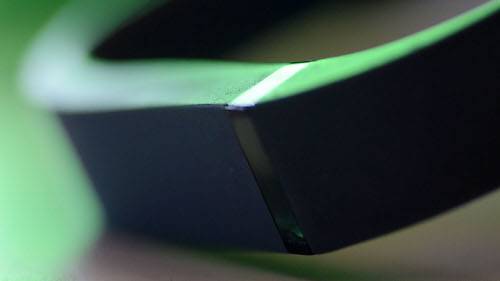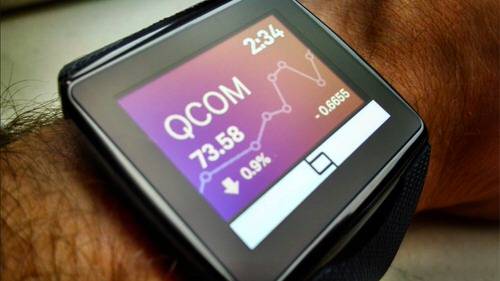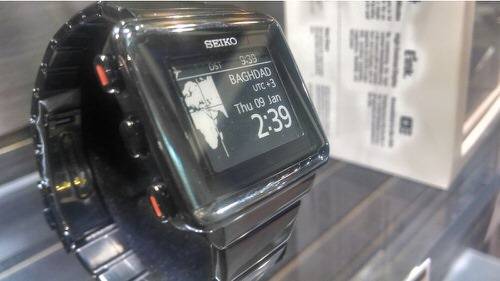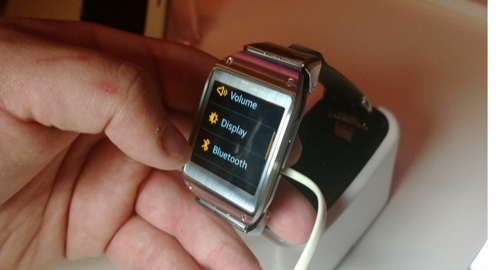Call me a dreamer, but I want it all. I want a watch that can receive notifications and make phone calls while also tracking my heartbeat and fitness activity—and without needing a recharge every day or so. Sadly, this watch does not yet exist.
See also: The Hard(ware) Realities Keeping Us From The Ideal Smartwatch
And it’s not likely to hit shelves any time soon, either. If the Consumer Electronics Show earlier this month gave us anything, it was a clearer view of just how the nascent wearable computing and smartwatch markets are evolving. Briefly put, you should get used to smart “watches” that require tethering (of one sort or another) to a smartphone in order to take advantage of its superior processing power and wireless capabilities.
That means smartwatches are most likely to serve as niche, satellite devices—notification/communication gadgets, for instance, or health-related fitness trackers—for the immediate future. It also means that you’re not likely to strap a smartphone onto your wrist any time soon—and no, Samsung’s ill-fated Galaxy Gear doesn’t count.
All that represents a fairly sharp break from the assumptions many people formed when smartwatch concepts started to emerge in Apple, Google and Samsung patent filings last year. The technical challenges to the standalone Everything Smartwatch, it turns out, are way more daunting than you might have thought.
The Incredible Shrinking PC
When computer engineers at companies like Apple, Google, Intel, Microsoft, etc. etc. etc. set their sights on the phone several years back, their challenge was simple, if not easy: Deliver PC-like computing power in a handheld package that could maintain a good wireless connection with decent battery life. The iPhone basically hit the mark, at least in a rudimentary way, in January 2007. From that point, we were off to the races.
The smartphone of today is often more powerful than the PC of just a few years ago. Smartphones and tablets in 2014 will be running on 64-bit architecture and some will have up to 4GB of RAM. No wonder netbooks are dead.

The watch, however, is different, and it’s pretty clear that no one is planning on rerunning the smartphone playbook just yet. That’s because there are some really big challenges in the way, which you could summarize as heat, juice and control.
Heat
Have you ever felt your smartphone get really hot when it’s doing heavy lifting like streaming video or playing a game? That’s because the processor is shedding excess heat generated by its furious electronic activity.
A smartwatch that handles computing tasks like a smartphone will need a processor with some serious chops—but it will also have to run much cooler than its smartphone cousins. You can’t easily set a smartwatch down if it gets too hot, and it really won’t do for it to melt your watchband or give you first-degree burns.

That’s one big reason smartwatches today seem underpowered, at least by smartphone standards. It’s telling, for instance, that the chip Qualcomm used for its Toq smartwatch isn’t a variant of its own Snapdragon processor, used in many of today’s smartphones. Instead, it’s an ARM Cortex-M3, a microcontroller often used to perform relatively low-level functions in appliances, factories and automobiles.
The Cortex-M3 lacks several of the integrated functions you’d find in a Snapdragon—chief among them, wireless and GPS capabilities. That saves on processing power, and thus reduces its heat output; it also keeps the chip small enough to fit reasonably into a watch. But it complicates the process of turning a wristbound device into a real connected computer.
The Cortex-M3 can, of course, still act as a traffic cop by routing around data from other chips—a pedometer accelerometer, for instance, or an external GPS receiver. (The iPhone 5S M7 motion co-processor is designed on Cortex-M3.) But those functions aren’t integrated into the Cortex-M3 chip itself, which is a big deal when you’re trying to pack as much raw computing power as you can into a tiny watch-sized package.
Worse, few chip manufacturers are likely to take on the challenge of squeezing all those functions onto a single chip until they’re convinced there’s a viable market for the resulting product. Doing so could take the clout of, say, an Apple—or maybe a Samsung.
Of course, several of the top smartwatches of 2013 do in fact rely on Snapdragon-class processors for their smarts. It’s just that those processors are actually in smartphones tethered to the watches.
Until someone solves the heat and power conundrum, smartwatches are going to remain poor cousins of the smartphone. That’s one big reason you’ve seen the wearables market specialize into many fitness bands and a couple of notification watches, but no device that combines those and other functions effectively. (Cost, of course, is also a factor; if your watch can’t be everything, which would be pricey in any event, why not do just a few things well for the lowest price you can manage?)
Juice
Battery life is pretty key to any watch, smart or otherwise. If the battery must be recharged or replaced frequently, the experience becomes more frustrating than useful. Unfortunately, two of the most important aspects of a smartwatch are the biggest battery hogs—the processor (see above) and the screen.
Samsung’s Galaxy Gear has a smartphone-style Super AMOLED display running an 800 MHz processor. This will come as a shock, but the Gear’s battery life is abysmal. Samsung predicts just 25 hours of continuous use; some reviewers counted themselves lucky to keep the watch charged for two full days, counting idle time.

Blame the screen. Only a few of today’s smartwatches can actually measure battery usage in days, not hours, and that’s largely because they’ve opted for alternative (and sometimes limited) screen technologies.
The Pebble, for instance, uses what it calls a “transflective LCD” made by Sharp; it’s monochrome and slow, but power-efficient. The Toq uses its own MEMS-based screen standard called Mirasol. E-Ink, the company that makes the screens for Amazon’s Kindle e-readers, also makes screens for some forthcoming, if rudimentary, smartwatches that can receive notifications (see here and here, for instance).
See also: Qualcomm’s Toq Smartwatch Shows Off The Future Of Displays
These alternascreens yield pretty good battery life for a watch, typically between four and 10 days. And some of them may be starting to catch on in a bigger way. HTC, for instance, has already licensed Qualcomm’s design and hardware kit, according to an individual familiar with the situation.
Control

Smartwatches, so far, are also just intrinsically hard to control. Keyboards, virtual or otherwise, are right out, and small screens limit the usefulness of touch-based controls. That leaves many modern smartwatches with side-button controls that bring to mind all the fun button-mashing of early digital watches and the gracefulness of texting from a numerical keypad.
Futuristic alternatives could save the day. Voice command and recognition, already present in Apple’s Siri and Google Now, is certainly one possibility. Gesture-based computing, sort of like what Google has done with X8 Computing System in the Moto X, might be another. Augmented reality displays like the examples in Google’s smartwatch patent could be interesting.
But any whiz-bang technology like this will take more processing power, thereby increasing demands on the processor and battery and generating more heat. It’s not an insoluble problem by any stretch of the imagination. But it is something of a vicious circle in the meantime.
Jewelry Or Computer?
When the incredible shrinking PC morphed from laptops and netbooks to phones and tablets, it met a compelling need: powerful mobile computing for an increasingly contextual and connected world. Wearable computing—again, at least for now—is in a different place.
Cellphones were already big before smartphones; everybody needs a phone of some sort, so a phone that did more stuff was a natural evolution for the vast majority of people. By contrast, not everybody needs or wants a watch, especially since the phone essentially subsumed the timekeeping function for many. (Even fewer people think they need a wearable device like Google Glass, which is much more, well, in your face.)
Watches have been and will probably always be jewelry, worn by some but not all. Even when if the fundamental problems of heat dispensation, battery life and processor are solved, it’s entirely possible that many people just won’t want to wear their computers on their bodies.
Until there’s a killer app that convinces them otherwise, that is.
Lead image via Flickr user Decade City, CC 2.0









